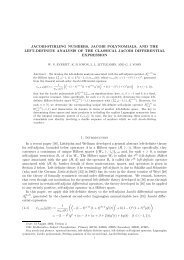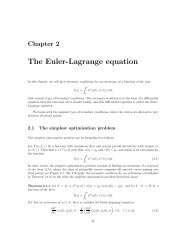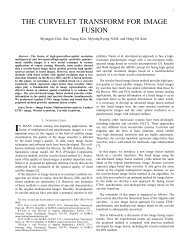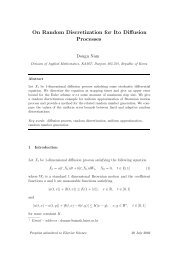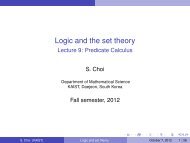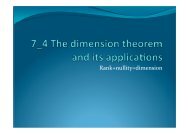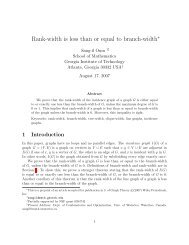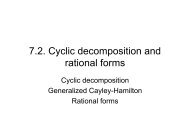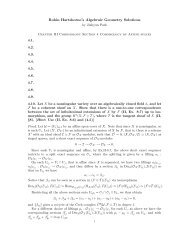Learning model structures based on marginal model structures of ...
Learning model structures based on marginal model structures of ...
Learning model structures based on marginal model structures of ...
You also want an ePaper? Increase the reach of your titles
YUMPU automatically turns print PDFs into web optimized ePapers that Google loves.
where the first inequality follows since G(P ) ⊆ e H ∗ . Since P ∈ M(G(P )), expressi<strong>on</strong> (4) impliesthat P is also Markov relative to H ∗ .If two nodes u and v are separated in a Markovian subgraph <strong>of</strong> a graph G, then so are theyin G by the property <strong>of</strong> a graph. We can extend this result to disjoint sets. Let C G (A) denote thecollecti<strong>on</strong> <strong>of</strong> the cliques which include nodes <strong>of</strong> A in G.THEOREM 3. (Theorem 4.2, Kim & Lee (2008)) Let G ′ = (V ′ , E ′ ) be a Markovian subgraph <strong>of</strong> Gand suppose that, for three disjoint subsets A, B, C <strong>of</strong> V ′ , 〈A|B|C〉 G ′. Then(i) 〈A|B|C〉 G ;(ii) For W ∈ C G (A) and W ′ ∈ C G (C), 〈W |B|W ′ 〉 G .4 MARKOVIAN SUBGRAPHS OF UNDIRECTED GRAPHSC<strong>on</strong>sider two Markovian subgraphs <strong>of</strong> G <strong>on</strong> A and B, G A and G B . Then by the transitivity property<strong>of</strong> the Markovian <strong>marginal</strong>izati<strong>on</strong> (Kim, 2006b), (G A ) B is also a Markovian subgraph <strong>of</strong> G, andsimilarly for (G B ) A . Furthermore, we can see, by definiti<strong>on</strong>, that(G A ) B = (G B ) A = G A∩B . (5)DEFINITION 2. For three disjoint and exhaustive subsets, A, B, and C, <strong>of</strong> V = V (G), we will callC a self-c<strong>on</strong>nected (SC) separator in G, if the following c<strong>on</strong>diti<strong>on</strong>s hold:(i) 〈A|C|B〉 G .(ii) G indCis c<strong>on</strong>nected.(iii) GCind does not c<strong>on</strong>tain any n-cycle (n > 3) nor a clique <strong>of</strong> G which c<strong>on</strong>sists <strong>of</strong> more than tw<strong>on</strong>odes.(iv) GA∪C ind and GindB∪Ceach c<strong>on</strong>sists <strong>of</strong> n-cycles (n > 3) or cliques <strong>of</strong> G <strong>on</strong>ly.According to the definiti<strong>on</strong>, we can see that, a SC-separator is given as a uni<strong>on</strong> <strong>of</strong> some intersecti<strong>on</strong>s<strong>of</strong> n-cycles (n > 3) or cliques. For example, in Figure 2, the SC-separator, {1, 2, 4, 5, 6},is the uni<strong>on</strong> <strong>of</strong> the intersecti<strong>on</strong>s <strong>of</strong> the following two pairs <strong>of</strong> cycles:12347856Figure 2: An undirected graph <strong>of</strong> 8 nodes.7



